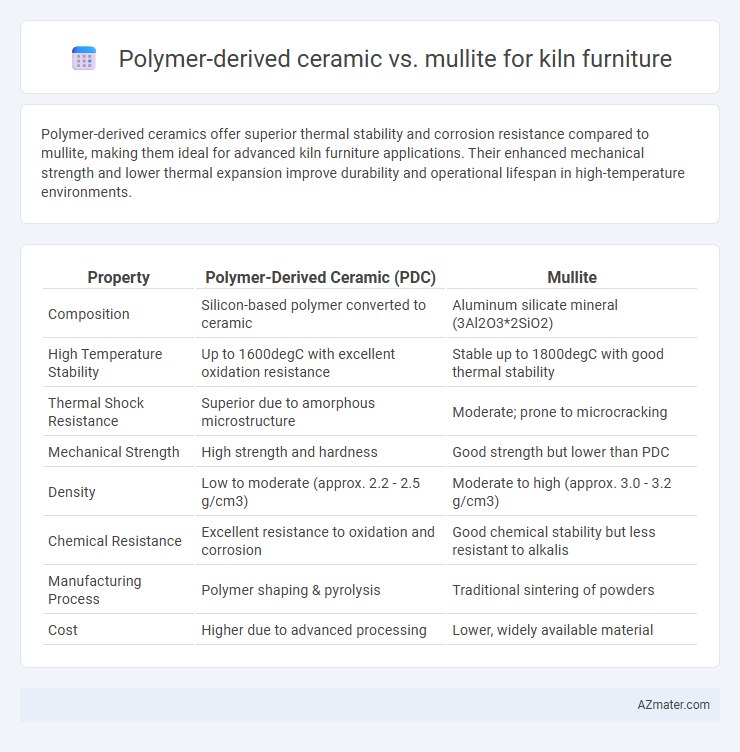Polymer-derived ceramics offer superior thermal stability and corrosion resistance compared to mullite, making them ideal for advanced kiln furniture applications. Their enhanced mechanical strength and lower thermal expansion improve durability and operational lifespan in high-temperature environments.
Table of Comparison
| Property | Polymer-Derived Ceramic (PDC) | Mullite |
|---|---|---|
| Composition | Silicon-based polymer converted to ceramic | Aluminum silicate mineral (3Al2O3*2SiO2) |
| High Temperature Stability | Up to 1600degC with excellent oxidation resistance | Stable up to 1800degC with good thermal stability |
| Thermal Shock Resistance | Superior due to amorphous microstructure | Moderate; prone to microcracking |
| Mechanical Strength | High strength and hardness | Good strength but lower than PDC |
| Density | Low to moderate (approx. 2.2 - 2.5 g/cm3) | Moderate to high (approx. 3.0 - 3.2 g/cm3) |
| Chemical Resistance | Excellent resistance to oxidation and corrosion | Good chemical stability but less resistant to alkalis |
| Manufacturing Process | Polymer shaping & pyrolysis | Traditional sintering of powders |
| Cost | Higher due to advanced processing | Lower, widely available material |
Introduction to Kiln Furniture Materials
Kiln furniture materials require exceptional thermal stability, mechanical strength, and resistance to thermal shock to withstand high-temperature environments. Polymer-derived ceramics offer superior microstructural control, enabling enhanced toughness and thermal shock resistance compared to traditional mullite, a widely used aluminosilicate ceramic known for its excellent thermal stability and low thermal expansion. The choice between polymer-derived ceramics and mullite depends on specific kiln conditions, with polymer-derived ceramics providing advanced performance in complex or rapidly cycling thermal regimes.
Overview of Polymer-Derived Ceramics
Polymer-derived ceramics (PDCs) offer superior thermal stability, oxidation resistance, and mechanical strength compared to traditional kiln furniture materials like mullite. PDCs are synthesized from pre-ceramic polymers, enabling precise control over composition and microstructure, which enhances their performance under extreme kiln conditions. Their lower density and higher fracture toughness make polymer-derived ceramics ideal for applications requiring durability and thermal shock resistance in high-temperature environments.
Understanding Mullite and Its Properties
Mullite, a key material for kiln furniture, possesses exceptional thermal stability withstanding temperatures exceeding 1,800degC while maintaining low thermal expansion and high creep resistance, crucial for industrial firing processes. Its chemical inertness and resistance to thermal shock make mullite ideal for supporting ceramic wares during high-temperature treatments without deformation or contamination. Compared to polymer-derived ceramics, mullite offers superior durability and reliability in prolonged exposure to extreme kiln environments.
Thermal Performance Comparison
Polymer-derived ceramics exhibit superior thermal shock resistance and a higher maximum operating temperature, typically exceeding 1600degC, compared to mullite's limit around 1500degC in kiln furniture applications. The enhanced thermal stability of polymer-derived ceramics results from their amorphous structure, which minimizes thermal expansion and prevents cracking under rapid temperature fluctuations. Mullite's crystalline structure offers good thermal insulation but falls short in thermal conductivity and durability under extreme cycling conditions compared to advanced polymer-derived ceramic materials.
Mechanical Strength and Durability
Polymer-derived ceramics exhibit superior mechanical strength compared to mullite, with tensile strength often exceeding 100 MPa, enhancing kiln furniture resilience under high thermal stress. Their amorphous microstructure contributes to excellent thermal shock resistance and long-term durability, outperforming the crystalline mullite which is more brittle and prone to microcracking. Polymer-derived ceramics also demonstrate higher oxidation resistance at temperatures above 1400degC, ensuring prolonged service life in harsh kiln environments.
Weight and Design Flexibility
Polymer-derived ceramics offer significantly lower weight compared to traditional mullite kiln furniture, enhancing handling and reducing structural load on kiln elements. Their advanced synthesis allows for greater design flexibility, enabling intricate shapes and optimized thermal performance tailored to specific firing conditions. In contrast, mullite's inherent brittleness and higher density limit customization and contribute to heavier kiln furniture components.
Resistance to Chemical Corrosion
Polymer-derived ceramics exhibit superior resistance to chemical corrosion compared to mullite, particularly in highly acidic and alkaline kiln atmospheres. Their unique microstructure resists degradation from molten salts and aggressive gases encountered during high-temperature processing. This enhanced chemical stability ensures longer service life and reduced maintenance for kiln furniture applications exposed to harsh environments.
Energy Efficiency and Firing Cycles
Polymer-derived ceramics exhibit superior energy efficiency in kiln furniture due to their lower thermal conductivity and faster heating rates compared to mullite, enabling reduced firing cycle durations. Mullite offers excellent thermal stability and mechanical strength at high temperatures but requires longer firing cycles, increasing overall energy consumption. The enhanced thermal shock resistance and uniform microstructure of polymer-derived ceramics contribute to prolonged kiln furniture lifespan and reduced downtime, optimizing kiln operation efficiency.
Cost Analysis and Long-Term Benefits
Polymer-derived ceramics (PDCs) offer higher initial material and processing costs compared to traditional mullite kiln furniture but provide superior thermal shock resistance and mechanical strength, leading to reduced maintenance and replacement expenses over time. Mullite is more cost-effective upfront due to widespread availability and established manufacturing methods but may incur higher long-term costs from frequent downtime and part failure under extreme kiln conditions. Evaluating total cost of ownership, PDCs deliver better economic value for high-performance applications requiring durability and minimal operational interruptions.
Application Suitability and Recommendations
Polymer-derived ceramics (PDCs) offer superior thermal stability, oxidation resistance, and complex shape fabrication capabilities, making them highly suitable for kiln furniture in high-temperature, oxidative environments. Mullite, known for its excellent thermal shock resistance, mechanical strength, and cost-effectiveness, remains preferred for applications requiring robust durability under cyclic heating but limited chemical exposure. For advanced, precision kiln components subjected to aggressive atmospheres, PDCs are recommended, while mullite ceramics serve well in conventional kiln furniture demanding long service life and economic efficiency.

Infographic: Polymer-derived ceramic vs Mullite for Kiln furniture
 azmater.com
azmater.com